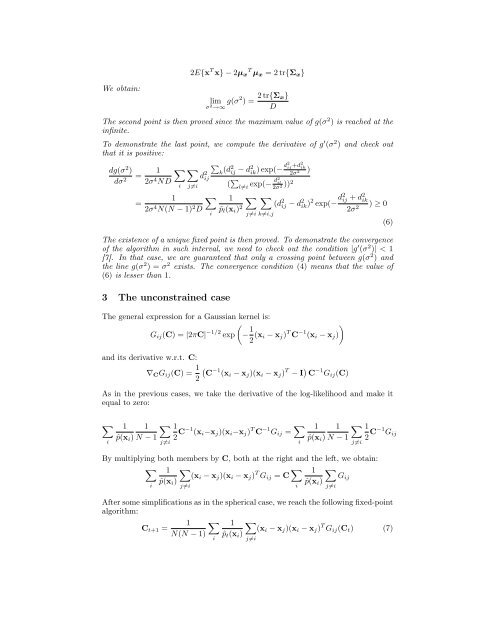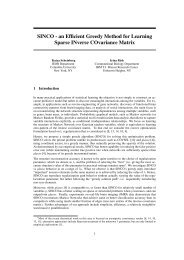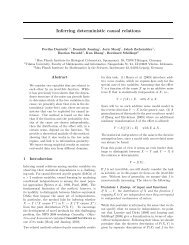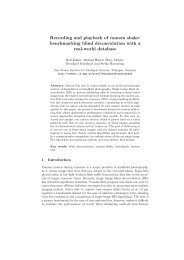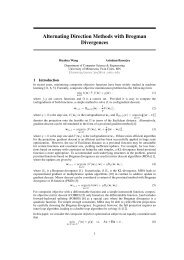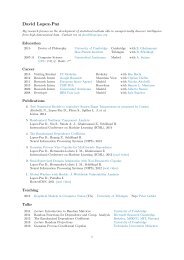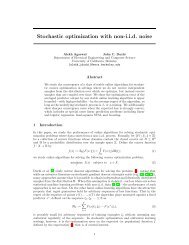Algorithms for Gaussian Bandwidth Selection in Kernel Density ...
Algorithms for Gaussian Bandwidth Selection in Kernel Density ...
Algorithms for Gaussian Bandwidth Selection in Kernel Density ...
Create successful ePaper yourself
Turn your PDF publications into a flip-book with our unique Google optimized e-Paper software.
We obta<strong>in</strong>:2E{x T x} − 2µ x T µ x = 2 tr{Σ x }limσ 2 →∞ g(σ2 ) = 2 tr{Σ x}DThe second po<strong>in</strong>t is then proved s<strong>in</strong>ce the maximum value of g(σ 2 ) is reached at the<strong>in</strong>f<strong>in</strong>ite.To demonstrate the last po<strong>in</strong>t, we compute the derivative of g ′ (σ 2 ) and check outthat it is positive:dg(σ 2 ) 1 ∑ ∑dσ 2 =2σ 4 ND=ij≠i12σ 4 N(N − 1) 2 Dd 2 ij∑k (d2 ij − d2 ik ) exp(− d2 ij +d2 ik2σ 2 )∑i( ∑ l≠i exp(− d2 il2σ)) 2 21 ∑ ∑ˆp l (x i ) 2 (d 2 ij − d 2 ik) 2 exp(− d2 ij + d2 ik2σ 2 ) ≥ 0j≠i k≠i,jThe existence of a unique fixed po<strong>in</strong>t is then proved. To demonstrate the convergenceof the algorithm <strong>in</strong> such <strong>in</strong>terval, we need to check out the condition |g ′ (σ 2 )| < 1[7]. In that case, we are guaranteed that only a cross<strong>in</strong>g po<strong>in</strong>t between g(σ 2 ) andthe l<strong>in</strong>e g(σ 2 ) = σ 2 exists. The convergence condition (4) means that the value of(6) is lesser than 1.3 The unconstra<strong>in</strong>ed caseThe general expression <strong>for</strong> a <strong>Gaussian</strong> kernel is:(G ij (C) = |2πC| −1/2 exp − 1 )2 (x i − x j ) T C −1 (x i − x j )(6)and its derivative w.r.t. C:∇ C G ij (C) = 1 2(C −1 (x i − x j )(x i − x j ) T − I ) C −1 G ij (C)As <strong>in</strong> the previous cases, we take the derivative of the log-likelihood and make itequal to zero:∑ 1 1 ∑ 1ˆp(xi i ) N − 1 2 C−1 (x i −x j )(x i −x j ) T C −1 G ij = ∑ ij≠i1 1 ∑ 1ˆp(x i ) N − 1 2 C−1 G ijj≠iBy multiply<strong>in</strong>g both members by C, both at the right and the left, we obta<strong>in</strong>:∑ 1 ∑i − x j )(x i − x j )ˆp(xi i )j≠i(x T G ij = C ∑ 1 ∑G ijˆp(xi i )j≠iAfter some simplifications as <strong>in</strong> the spherical case, we reach the follow<strong>in</strong>g fixed-po<strong>in</strong>talgorithm:1 ∑ 1 ∑C t+1 =(x i − x j )(x i − x j ) T G ij (C t ) (7)N(N − 1) ˆpi t (x i )j≠i


